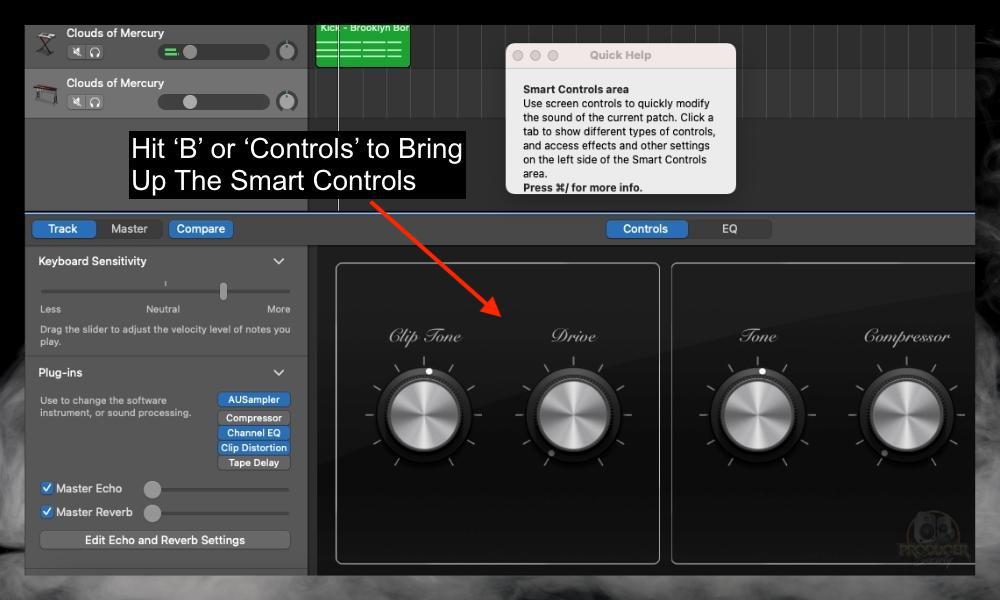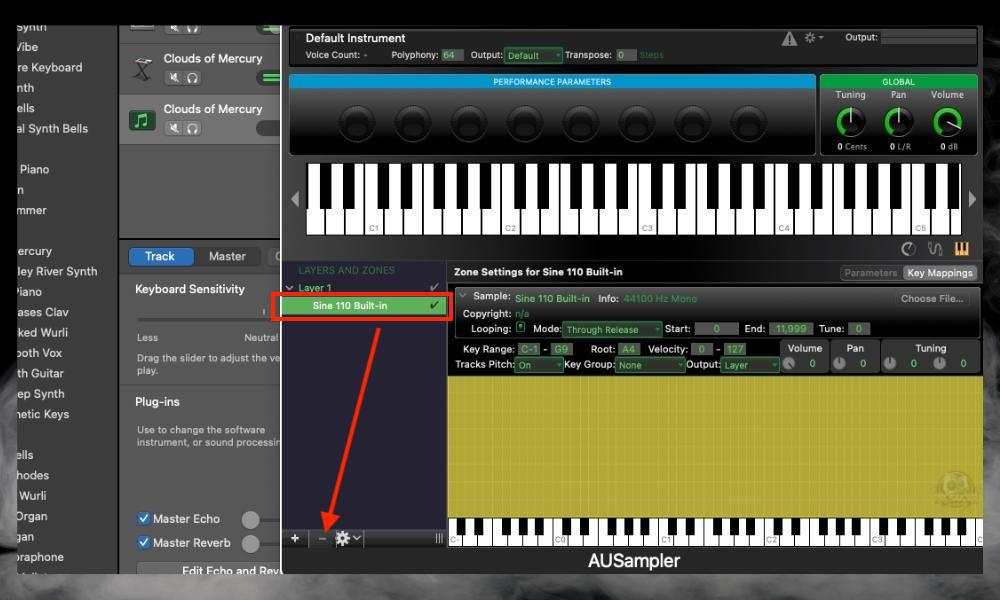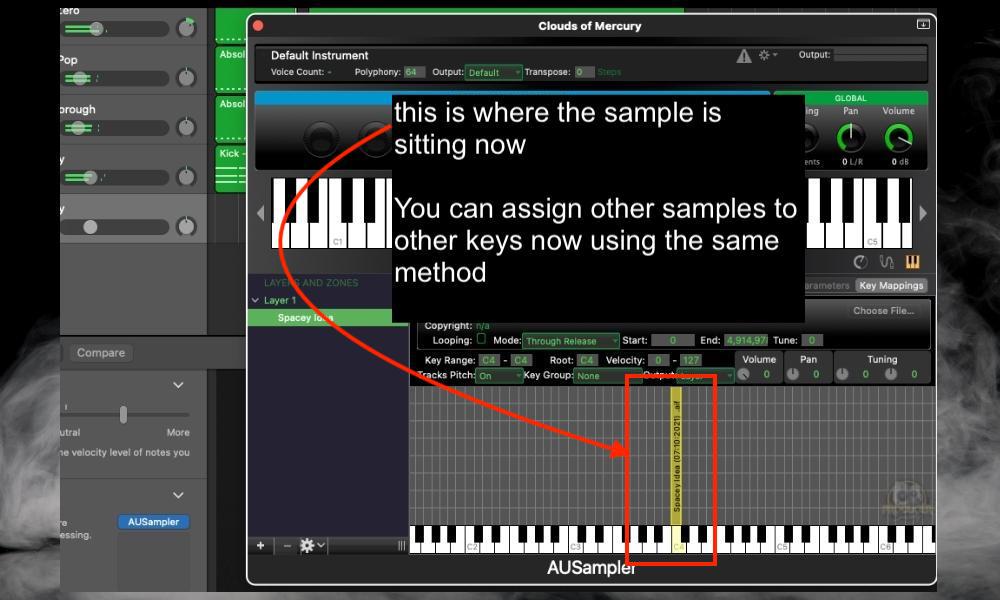How To Add Samples To Garageband
The AUSampler is one tool in GarageBand that I nonetheless don't grasp 100%. There seem to be many parts of it that I just don't quite get even so, however, I learn a piffling bit more about information technology whenever I have to do something new with it. I thing that I recently learned how to do was assign samples to individual keys.
This tactic works for not simply GarageBand's Musical Typing feature only too for an external MIDI keyboard that'southward connected to your computer. Simply put, yous tin can assign a sample to every single key on the keyboard – each i different from the terminal. And so how do you really get nearly doing this?
To assign samples to a MIDI keyboard in GarageBand
1) Open up the Sampler with AU Instruments > Apple > AUSampler
two) Printing the gear icon, so "Add Sample"
iii) Open the Sample
four) Eliminate the "Sine 110 Born" with the Subtract Button
5) Cull the Fundamental Range, ie, "C-4," and and then the fundamental "C4"
This is the burden of how you assign samples to the MIDI keyboard in GarageBand, and the great thing about this is that it will work with the Musical Typing keyboard, a MIDI keyboard continued with an audio interface, or via a more modern USB-C connection. Without further ado, let'south explore a more than in-depth and illustrated explanation of how to do this.
By the way, I'm always on the lookout for deals in the music manufacture (at that place'south usually something if you know where to wait). Right now, there are 3 deals that stick out to me
How To Assign Samples To All Keyboards in GarageBand
In case you oasis't already seen it before, I posted a cursory video on how to do this in my guide on how to connect a MIDI keyboard to GarageBand. The whole article runs through how to set up a MIDI keyboard with GarageBand and it's really quite thorough (the Arturia KeyLab 61 MKII is the best one to get from Amazon past the way).
First, I'll bear witness you the video on assigning samples, so I'll evidence how information technology'due south done with text and pictures the way I normally do:
1) Hitting 'B' On Your Keyboard to Bring Up the Smart Controls

Obviously, the first thing you want to do is bring up the Smart Controls past either pressing 'B' on your keyboard, or by clicking on the "Controls" tab that's shown in the image above. The fastest mode, no doubt, is to just use the keyboard shortcut (my comprehensive listing of those).
2) Click A Plugin Slot and So AUInstruments > Apple > AUSampler > Stereo

Bring upward the AUSampler using the path I merely showed you. You tin choose Stereo or Mono, depending on your needs, but I nearly never choose Mono.
I believe when you choose Mono, information technology puts the entire audio in mono (in the center), rather than stereo (left and correct). There are other ways of putting sounds into Mono as well, including with the Gain plugin as I pointed out in my guide on mono mixing.
3) Press the Gear Icon and Then "Add Sample"

If you've read my GarageBand sampling tutorial, you'd know that it can be cumbersome at times. The reason is sometimes files are on the iCloud and you don't know information technology. Or the file format isn't suited for the AUSampler.
Sometimes it seems there is no rhyme or reason why the Sampler won't import a file the mode you want it to. That said, my way around this (which continues to work for me), is to take it either equally a .aif file or a .wav file. Both of these file formats seem to work consistently.
Additionally, I have the sample sitting on my desktop and I ordinarily make sure information technology's not on my iCloud bulldoze. Although, for this tutorial, I did use a file in the iCloud Drive and information technology worked.
4) Select the Sample and And so "Open"
Afterward you've called your sample, y'all merely want to click Open, and then information technology volition load into the AUSampler. If you're running all of your sounds, instruments, and GarageBand itself from an SSD like the one I use from Amazon, information technology may take a 2nd for everything to go through (here's my guide on how to set up the SSD, past the way).
I think it also took an extra second considering I did what I only brash y'all non to do: load it from the iCloud Bulldoze. Next, you lot want to eliminate the pesky Sine 110 Born instrument because it'll play alongside your sample. Information technology'll sound terrible so make sure y'all get rid of information technology.
5) Click "Sine 110 Built-In" And And so the Decrease '-' Button

There are two means of eliminating the Sine 110 Built-In musical instrument. Ane is to only click on information technology followed by the decrease symbol "-." That should normally be enough for it to disappear, nonetheless, you can besides click on the checkmark to bypass it.
When you bypass information technology, it doesn't get rid of it. It temporarily bypasses it until y'all switch it back on. This may be something you adopt to do, really.
6) Within the AUSampler, Choose the Key Range, "C-4," and so the Primal, "C4"

In essence, to assign samples to your MIDI keyboard in GarageBand, you accept to utilise the "Central Range" parameter which is clearly outlined in the paradigm above.
It tin can accept a second to figure it out so exist patient. The first affair you should know is that the offset column, indicated by a dash "-" between the number, appears to show the octave range.
Whereas the 2d value – which does non accept a dash between the letter and number – appears to stand for the specific key. You accept to designate within what octave range yous want to assign the sample.
That's kind of a mouthful, so here's an example: within the octave C4 (which represents the notes from C4 all the mode until the fifth C on the keyboard), I've assigned the sample at the first octave which is but "C4."
If this confuses you, have a look at the video near the start of the article, because information technology shows you how it works in existent-fourth dimension.
7) Repeat the Process for Other Samples and Keys

And that's pretty much it for assigning samples to the MIDI keyboard in GarageBand. I'm not entirely sure what the limit is for assigning samples, but I imagine you can practise this for a while.
The question is why though? I'm non much for sampling and I never have been, although, that may alter at some point in the future.
Of import Things to Note Nearly Assigning Samples in GarageBand
i) The Old Mode No Longer Works
There was a YouTube video from ages agone that showed you how to assign samples the old manner, only it no longer works. To exist honest, I think the older way was better because I believe you lot could only load the samples right onto the keys of the Musical Typing feature. Pretty neat.
Gear Mentioned
1) Arturia KeyLab 61 MKII (from Amazon)
two) Samsung T5 Portable SSD 2TB (on Amazon)
How To Add Samples To Garageband,
Source: https://producersociety.com/assign-samples-to-midi-keyboard-garageband/
Posted by: malonelencente.blogspot.com


0 Response to "How To Add Samples To Garageband"
Post a Comment